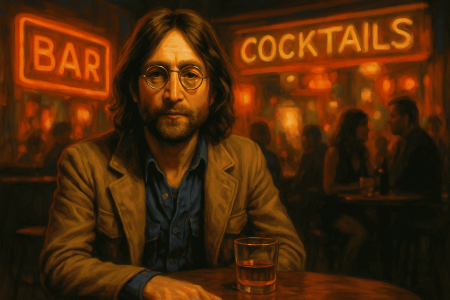Between 1973 and 1975, John Lennon entered what he later called his “Lost Weekend”—an 18-month stretch of chaos, creativity, and change. After splitting from Yoko Ono, he moved to Los Angeles and started a relationship with May Pang, his assistant at the time. What followed was a whirlwind of wild nights, raw emotion, and some of the most unexpected moments in his solo career. Far from just a drunken detour, this chapter revealed a different side of Lennon—untethered, unfiltered, and deeply human.
Background
By 1973, things between John Lennon and Yoko Ono had grown tense. Their once-close bond was under stress from fame, creative pressure, and personal struggles. They argued often, and the spark that had once connected them was fading.
Lennon was also dealing with a lot inside. He felt lost, unsure of his place as an artist and partner. Drinking became a way to cope. He was tired, angry, and often sad. The weight of being John Lennon was wearing him down.
The break wasn’t meant to last forever. Yoko, seeing how things were falling apart, suggested they take time apart. She even encouraged John to spend time with May Pang, someone they both knew well. It was an unusual choice, but one that came from a need for peace—not revenge.
Life in L.A.
Lennon’s time in Los Angeles was loud, wild, and unpredictable. He dove headfirst into the city’s rock-and-roll scene, spending nights at clubs and private parties, often drinking too much and stirring up trouble. He became known for outrageous behavior—getting thrown out of bars, shouting at strangers, and even wearing a sanitary pad on his head at the Troubadour Club.
But it wasn’t all chaos. Lennon was also surrounded by music. He reconnected with old friends and made new ones, including Harry Nilsson, with whom he shared both a deep bond and a wild streak. Their friendship led to drunken misadventures but also creative work, including sessions for Nilsson’s Pussy Cats album, which Lennon produced. Other musicians like Keith Moon and Ringo Starr drifted in and out of the scene, turning each day into a mix of music, madness, and mayhem.
Through it all, L.A. became a strange kind of escape—a place where Lennon could fall apart and, at times, pull himself back together.
Creative Output
Despite the chaos, Lennon’s “Lost Weekend” was one of his most productive solo periods. In 1974, he released Walls and Bridges, an album shaped by heartbreak, self-reflection, and a raw sense of honesty. It featured “Whatever Gets You Thru the Night,” his only solo No. 1 hit during his lifetime, and “#9 Dream,” a dreamy track born from that strange in-between space he was living in.
He also returned to his roots with Rock ’n’ Roll, a covers album paying tribute to the music that first inspired him. The sessions were messy and drawn-out, but the final record showed his deep love for early rock classics—even if it was recorded through a haze of exhaustion and drink.
This period forced Lennon to look inward. Stripped of the stability he had with Yoko, and surrounded by unpredictable energy, his songwriting became more personal, more vulnerable. The “Lost Weekend” didn’t just push him to the edge—it pushed his music into new, sometimes uncomfortable, but deeply honest places.
The Role of May Pang
May Pang wasn’t just a bystander in Lennon’s life during the “Lost Weekend”—she was a steady presence in the storm. Though their relationship began under unusual circumstances, Pang became both a partner and a grounding force. She helped Lennon reconnect with his son Julian, encouraged him to repair friendships, and supported his return to regular recording sessions.
Privately, their relationship was more than a fling. Lennon showed genuine affection for Pang, and they shared moments of calm amid the chaos. Publicly, though, things were complicated. He was still legally married to Yoko, and much of the media attention focused on his wild behavior, not the person beside him.
Still, Pang’s influence ran deep. She reminded Lennon of what he’d drifted away from—family, focus, and the simple joy of making music. Many of the small steps he took toward healing during this time began with her quiet support.
Return to Yoko Ono
In early 1975, Lennon and Ono quietly found their way back to each other. The reunion wasn’t dramatic—it was private, careful, and shaped by time. Yoko had stayed in touch during his time with May Pang, and when Lennon returned to New York, their conversations deepened. She offered a path back, and he took it.
Soon after, Yoko became pregnant with their son, Sean. Lennon stepped away from the spotlight to focus on fatherhood, entering a new phase of his life marked by peace and routine. He often spoke of the “Lost Weekend” with a mix of humor and regret. He called it lost, but not wasted.
Lennon admitted he’d needed the time apart to rediscover parts of himself. The chaos, the mistakes, even the love—all of it had shaped the man he became when he walked back through Yoko’s door.
Closing Thoughts
The “Lost Weekend” was a messy, unpredictable chapter in John Lennon’s life—but also one of deep importance. It pulled him out of his comfort zone, tested his limits, and sparked some of his most honest solo work. Behind the headlines and wild nights was a man wrestling with fame, love, and identity.
Far from being just a footnote, this period shaped the Lennon who would later step away from music to raise his son and live more quietly. It exposed both his flaws and his resilience. In the story of John Lennon, the “Lost Weekend” wasn’t just time lost—it was time lived, raw and real, and it left its mark.
